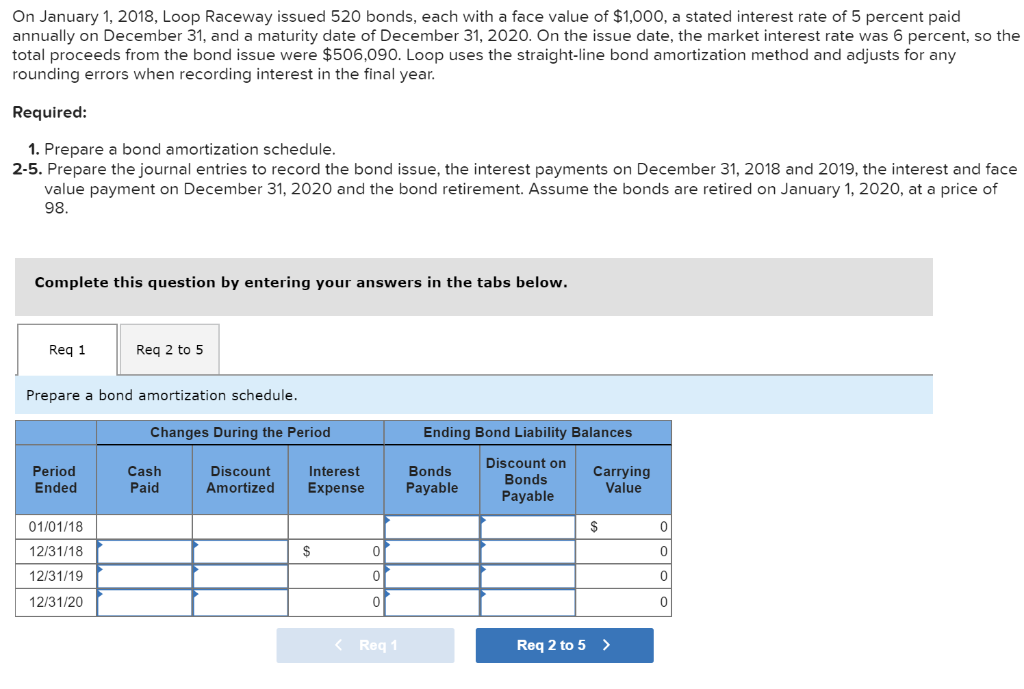Answered step by step
Verified Expert Solution
Question
1 Approved Answer
1 Record the issuance of 520 bonds at face value of $1,000 each for $506,090. 2 Record the interest payment on December 31, 2018. 3


-
1
Record the issuance of 520 bonds at face value of $1,000 each for $506,090.
-
2
Record the interest payment on December 31, 2018.
-
3
Record the interest payment on December 31, 2019.
-
4
Record the interest and face value payment on December 31, 2020.
-
5
Record the retirement of the bonds at a quoted price of 98, assuming the bonds are retired on January 1, 2020.
General journal entry options:
- No Journal Entry Required
- Accounts Payable
- Accounts Receivable
- Accumulated Amortization
- Accumulated DepreciationBuildings
- Accumulated DepreciationEquipment
- Accumulated DepreciationVehicles
- Accumulated Other Comprehensive Income
- Additional Paid-In Capital, Common Stock
- Additional Paid-In Capital, Preferred Stock
- Additional Paid-In Capital, Treasury Stock
- Advertising Expense
- Allowance for Doubtful Accounts
- Amortization Expense
- Bad Debt Expense
- Bonds Payable
- Buildings
- Cash
- Cash Equivalents
- Cash Overage
- Cash Shortage
- Charitable Contributions Payable
- Common Stock
- Copyrights
- Cost of Goods Sold
- Deferred Revenue
- Delivery Expense
- Depreciation Expense
- Discount on Bonds Payable
- Dividends
- Dividends Payable
- Donation Revenue
- Equipment
- FICA Payable
- Franchise Rights
- Gain on Bond Retirement
- Gain on Disposal of PPE
- Goodwill
- Impairment Loss
- Income Tax Expense
- Income Tax Payable
- Insurance Expense
- Interest Expense
- Interest Payable
- Interest Receivable
- Interest Revenue
- Inventories
- Inventory - Estimated Returns
- Land
- Legal Expense
- Licensing Rights
- Logo and Trademarks
- Loss on Bond Retirement
- Loss on Disposal of PPE
- Natural Resource Assets
- Notes Payable (long-term)
- Notes Payable (short-term)
- Notes Receivable (long-term)
- Notes Receivable (short-term)
- Office Expenses
- Other Current Assets
- Other Noncurrent Assets
- Other Noncurrent Liabilities
- Other Operating Expenses
- Other Revenue
- Patents
- Payroll Tax Expense
- Petty Cash
- Preferred Stock
- Premium on Bonds Payable
- Prepaid Advertising
- Prepaid Insurance
- Prepaid Rent
- Refund Liability
- Rent Expense
- Rent Revenue
- Repairs and Maintenance Expense
- Restricted Cash (long-term)
- Restricted Cash (short-term)
- Retained Earnings
- Salaries and Wages Expense
- Salaries and Wages Payable
- Sales Revenue
- Sales Tax Payable
- Service Revenue
- Short-term Investments
- Software
- Subscription Revenue
- Supplies
- Supplies Expense
- Travel Expense
- Treasury Stock
- Unemployment Tax Payable
- Utilities Expense
- Vehicles
- Withheld Income Taxes Payable


Step by Step Solution
There are 3 Steps involved in it
Step: 1

Get Instant Access to Expert-Tailored Solutions
See step-by-step solutions with expert insights and AI powered tools for academic success
Step: 2

Step: 3

Ace Your Homework with AI
Get the answers you need in no time with our AI-driven, step-by-step assistance
Get Started


